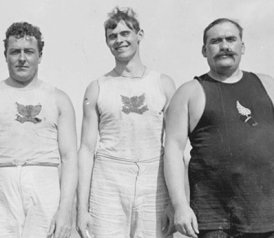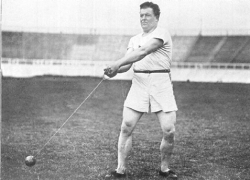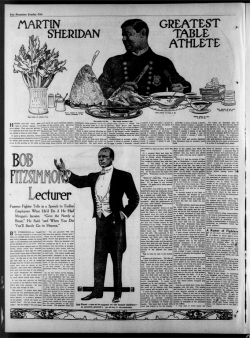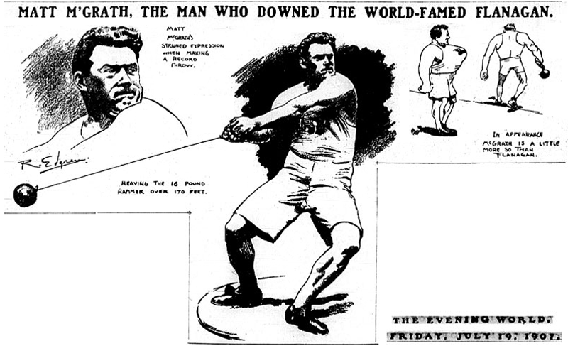The Irish Whales
America’s gluttonous, English-hating, gold-medal-winning Olympic heroes of the early 20th century.

Americans love outsized heroes: Paul Bunyan, the 50-foot woman, Mr. T. It’s no surprise, then, that some of our first Olympic legends were giants. Given the general mistrust of foreigners in the early 20th century, it’s a little more surprising that many of these beloved discus and hammer throwers and shot-putters were born in Ireland. These men, known as the Irish Whales, were at once American heroes and exotic curiosities—monumental figures who appeared just on the cusp of broader Irish acceptance in America.
As they tried to assimilate in the late 1800s, Irish-American immigrants embraced popular professional sports like boxing, baseball, and pedestrianism (which has evolved into the much less popular pastime of racewalking). These were the games of the masses, a place to make your name athletically but not the best venue for social mobility. When a new amphitheater opened at Madison Square in 1890, the New York Times remarked approvingly, and with pretty shoddy foresight, “There is no trace or flavor of the circus, the walking match, pugilism, or the dog show about this new Garden.” The obvious meaning: This is a classy place, one not fit for Irishmen.
Amateur sports were the refuge of Yale and Harvard boys in white leotards. Sportswriter Caspar Whitney, an early proponent of the Olympic movement, wrote in 1895’s A Sporting Pilgrimage that the “vermin” of the professional athletic class had no place in amateur sports. He bemoaned the idea of “bring[ing] together in sport the two divergent elements of society that can never by any chance meet elsewhere on even terms.”
At least some of the “vermin” were not stymied by blue-blooded objections. In 1898, a group of recent immigrants formed the amateur Irish-American Athletic Club in Queens, New York. The club, which over the years included Italians, Jews, and African-Americans, served as an alternative to the exclusive, WASP-y New York Athletic Club. Its symbol was a winged fist flanked by shamrocks and American flags—not the IAAC’s last attempt to balance its allegiances.
It didn’t take long for IAAC members to crack the U.S. Olympics team. By 1908, the Irishmen were already fixtures on the American squad. Most contemporary U.S. coverage of that year’s games focused on American heroism, English perfidy, or both. Allegations of host-country cheating ran rampant: English officials tampered with the marathon finish; the discuses weren’t regulation weight; the British tug-of-war team gained an advantage with their metal-rimmed boots.
Three years after the formation of Sinn Fein, less than a decade before the Easter Rising, this was the perfect moment for Irish-Americans to find common cause with their adopted country in hating the English. One highly believable but probably apocryphal tale has IAAC member and discus gold medalist Martin Sheridan egging on U.S. flag-bearer Ralph Rose in his famous refusal to lower the American flag to King Edward VII at the opening ceremony, saying, “This flag dips to no earthly king.” When it came to the controversially heavy boots of the English tug-of-war team, Sheridan, in his column for the New York Evening World, quipped, “The Englishmen had to waddle out on the field like a lot of County Mayo ganders going down to the public pond for a swim.”

Special thanks to IAAC archivist Ian McGowan.
But appeals to nationalism weren’t necessary in cementing the IAAC’s fame in London. Members of the club won nearly half of America’s 23 gold medals, including the first awarded to an African-American, relay sprinter John Baxter Taylor Jr. In massive celebratory parades in New York City after the athletes returned to America, Irish flags waved next to American ones and spectators sang “The Wearing of the Green” as well as “The Star-Spangled Banner.” Johnny Hayes, IAAC member and marathon gold medalist, was lionized as a symbol of American hard work and Irish cockiness—a “real New York boy” who was simultaneously “as Irish as you find them,” according to the New York Sun. There was a bit of grumbling that Tammany Hall’s hand was behind the celebrations, and some papers complained that IAAC members were competing against the New York Athletic Club (and therefore the Protestant establishment) instead of against their Olympic foes. But the overall tone was one of proprietary affection: Irish-American athletes might be outsiders, but they’re our outsiders.
With the gargantuan, weight-tossing Irish Whales, this slightly distancing adulation reached its apex. Many of the athletic giants—a group that included John Flanagan, Simon Gillis, Pat “Babe” McDonald, Matt McGrath, Pat or Paddy Ryan, and Martin Sheridan—were major stars from the beginning of the century. The Irish-born Flanagan won gold medals in the hammer throw in 1900, 1904, and 1908, breaking the Olympic record multiple times. (Like many of the other Whales, he supported his amateur athletic career by working as a New York City policeman.) Sheridan and McGrath also medaled in 1908, the former winning gold in two discus events and bronze in the long jump and the latter placing second behind Flanagan in the hammer throw. In August 1908, the Irish World printed a poem, “Flanagan, Sheridan, McGrath,” celebrating the athletes’ dominance and mocking any other nation that dare challenge it: “English and Scottish and Dutch, / Russians and French and Jews, / We ask their pardon as such, / And hope they will please excuse.”
At the 1912 Games in Stockholm, the legend of the Whales grew still larger. This had as much to do with their Rabelaisian appetites as their athletic success. A writer for the Sun who crossed the Atlantic with the American team on the SS Finland reported that “the consumption of food by the huge athletes entered in the shot put hammer and discus” was putting the ship’s waiters—and meat storage lockers—to some strain.* (According to a later account, the group’s nickname was bestowed by one of these unlucky servers, who lost 20 pounds ferrying around trays of soup and steak and moaned, “It’s whales they are, not men.”) One waiter named Alphonse was fired after his first day, explained weight thrower Matt McGrath, because he was “one o’ them thick-headed foreigners who won’t do what you tell them,” in this case bringing them “everything at once.” A second waiter, McGrath continued, brought too much “spaghetti and rice and a lot of other things which are all right for the snail-eating peoples but which don’t fit in with throwing the hammer.”

San Francisco Sunday Call.
The high-carb diet didn’t daunt the Whales once they arrived in Sweden. McGrath won gold in the hammer throw, McDonald in shot put. Martin Sheridan, who remained an object of popular fascination although 1908 was his last Olympics, was awarded the title “Greatest Table Athlete” by the San Francisco Call in 1913 for a daily menu that included, just for lunch, a six-pound pig’s head, 12 potatoes, three “heaping” plates of cabbage, four ears of corn, half a loaf of bread, and two pieces of pie.
Over the years, the Whales became pop-culture stars, partially through product endorsements that even in the supposedly pure days of "amateur" athletics were apparently not a barrier to Olympic success. Sheridan, McGrath, and McDonald all appeared in ads for Tuxedo Tobacco (Sheridan: “I advise all athletes to stick to Tuxedo”), Flanagan and Sheridan for Spalding sporting goods, and McGrath (as “America’s Most Famous Policeman Athlete”) for Lifebuoy Soap. They continued to dominate their events as well: In 1920, with Matt McGrath injured, Pat Ryan won gold in the hammer and “Babe” McDonald was victorious in the 65-pound weight toss. McGrath, who was in his late 40s, returned in 1924 to take silver in the hammer throw, capping off the Whales’ formidable streak on the medal stand.
The Whales’ final victories could be claimed entirely for America, and not for the IAAC, which disbanded in the early 1920s. The immediate reasons for the club’s dissolution, as IAAC archivist Ian McGowan writes in a recent article for Irish America magazine, were the war and a Prohibition-era crackdown on bootleggers at Celtic Park, where the IAAC held social events. But the notion of competing for an ethnic subgroup, and not for America as a whole, was becoming obsolete. The blatant, “No Irish Need Apply” racism of the 19th century was fading away by the 1920s as the Irish entered the white middle class. By the 1950s and 1960s, New York Times sports columnist Arthur Daley was regularly drawing on the Whales as all-American symbols—colorful examples of the manly giants who once walked among us. “They may have been whales,” he wrote in 1954, describing a meal shared among Gillis, McGrath, and McDonald that involved 27 dozen oysters and six T-bone steaks. “But they were also MEN.”

Robert Edgren cartoon in The Evening World. July 19, 1907. Courtesy IAAC archivist Ian McGowan/Wingedfist.com.
In their time, however, the Whales represented some of the curious paradoxes of the American outsider. They became insiders largely by trouncing or mocking other, more-threatening outsiders, whether the English or McGrath’s “thick-headed foreigners” and “snail-eating peoples.” Fame came not just for their athletic skills but for their cartoonish, nearly grotesque physical attributes: They were larger than life, in a way that turned them into benevolent circus freaks. For later generations navigating the complexities of race and athletics in America, the Whales would be an early harbinger.
Correction, Aug. 1, 2012: This article originally stated that the American Olympic team traveled to the 1912 Olympics on the USS Finland. The boat was known as the SS Finland in 1912. It was later commissioned by the Navy and became the USS Finland. (Return to the original sentence.)
Read the rest of Slate’s coverage of the London Olympics.